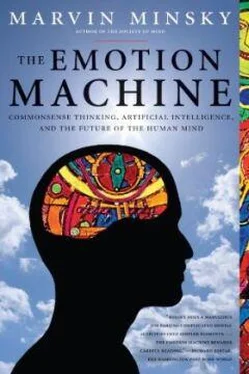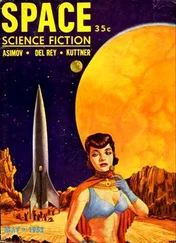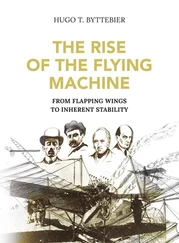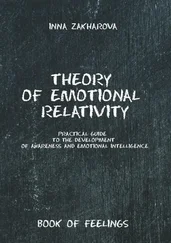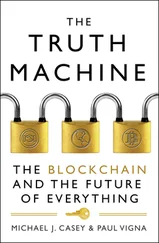Chapter III of The Descent of Man
Turing described these “universal” machines before any modern computers were built. For more details about how these work, see http://mathworld.wolfram.com/UniversalTuringMachine.html.
This switching usually happens so quickly that we don’t notice it; this is a typical instance of the Immanence Illusion [See §4-3.1.]
There is a detailed theory of how this works in §24.6 Direction-Nemes of The Society of Mind.
It was recently discovered only recently that people often do not perceive some very large changes in a scene. See [give reference] for astonishing demonstrations of this.
From http://web.media.mit.edu/~minsky/papers/Frames/frames.html
See Chapter 3 of William Calvin, How Brains Think, Basic Books, 1966.
For more details about the relations among different nearby things, see chapter 24 of SoM, which also tries to explain why the shapes of things don’t seem to change when we look at them from different directions—as well as why things don’t seem to change their locations when you move your eyes.
I wonder if Hume had some such idea when he said: “All belief of matter of fact or real existence is derived merely from some object, present to the memory or senses, and a customary conjunction between that and some other object. … [This results from] a species of natural instincts, which no reasoning or process of the thought and understanding is able either to produce or to prevent.” —David Hume, An Enquiry Concerning Human Understanding, 1748.
David Hume, ibid. Part II.
Hume was especially concerned with this question of how evidence can lead to conclusions: “It is only after a long course of uniform experiments in any kind, that we attain a firm reliance and security with regard to a particular event. Now where is that process of reasoning which, from one instance, draws a conclusion, so different from that which it infers from a hundred instances that are nowise different from that single one? I cannot find, I cannot imagine any such reasoning.”
Note that this is a difference-engine ‘in reverse,’ because it changes the internal description, instead of changing the actual situation. See “Verbal expression” in SoM §22.10).
Robert Stickgold et al., Cognitive Neuroscience (Vol. 12, No. 2) in March 2000, also Nature Neuroscience (Vol. 3, No. 12) in December 2000.
Another answer might be that some information is stored ‘dynamically’—for example by being repeatedly echoed between two or more different clusters of brain cells.
I described a similar system for verbal communication in §22.10 of SoM.
The K-line idea was first developed in [Ref: Plain Talk] and [Ref: K-lines]. Chapter 8 of SoM describes more ideas about what might happen when K-lines conflict.
Perhaps she used that facial expression to help her maintain her concentration. If this became part of her subsequent skill, it could later be hard to eliminate.
In the field of Artificial Intelligence, the importance of credit-assignment was first recognized in Arthur Samuel’s research on machine learning. [Ref.]
A. Newell, “The chess machine,” in Proc. Western Joint Computer Conf. March 1955.
People often describe such moments as the times at which they make their decisions—and then regard these as ‘acts of free will.” However, one might instead regard those moments as merely the times at which one’s ‘deciding’ comes to a stop.
Presumably, these capacities also may vary among different parts of the same mind.
Some of this section is adapted from §7.10 of SoM.
Harold G. McCurdy, The Childhood Pattern of Genius. Horizon Magazine, May 1960, pp. 32-38. McCurdy concluded that mass education in public schools has “the effect of reducing all three of the above factors to minimum values.”
Where do we get those default assumptions? Answer: we usually make a new frame by making changes in some older one, and values that were not changed at that time will be inherited from those older ones.
I should add that a frame can include some additional slots that activate other processes or sets of resources. This way, a frame could transiently activate ways to think—so that one almost instantly knows how to deal with some familiar object or situation.
I should add that numerical representations have many useful applications. However, even when those numbers have some practical use, one can only alter them by increasing or decreasing them, but cannot add other nuances. It is much the same ‘logical’ systems; each ‘proposition’ must be true or false, so the system still uses something like numbers, except that their values can only be 0 or 1. Also, see see SOM, section 5.3.
§§20.1 of SoM argues that even our thoughts can be ambiguous.
Also, several such functions could be superimposed in the very same spatial regions, by using by genetically distinct lines of cells that interact mainly among themselves.
Later Kant claims that our minds must start with some rules like “Every change must have a cause.” Today, one might interpret this as suggesting that we’re born with frames that are equipped with slots that we tend to link to the causes of changes. In the simplest case, of course, that need could be satisfied by a link to whatever preceded the change that occurred; in later years we could learn to refine those links.
There is more discussion of this in web.media.mit.edu/~minsky/papers/SymbolicVs.Connectionist.html.
Daniel Dennett, in The Cambridge Dictionary of Philosophy. A similar premise was prevalent before the dawn of modern genetics: that every sperm already contained a perfectly formed little personage. However, in Brainstorms , 1978, Daniel Dennett goes on to point out that, “Homunculi are bogeymen only if they duplicate entire the talents they are rung in to explain. If one can get a team or committee of relatively ignorant, narrow-minded, blind homunculi to produce the intelligent behavior of the whole, this is progress.”
Here we use “Model of X” as in §4-3 to mean any structure or process that one can use to answer some questions about X.
We’ll review some traditional ‘unified theories of psychology in §§Models Of Mind.
“The Trouble With Psychological Darwinism” at http://www.lrb.co.uk/v20/n02/fodo01_.html
See http://www.theabsolute.net/minefield/witforwisdom.html
Greg Egan Diaspora, Millennium, 1998, ISBN 0-75280-925-3
Читать дальше
